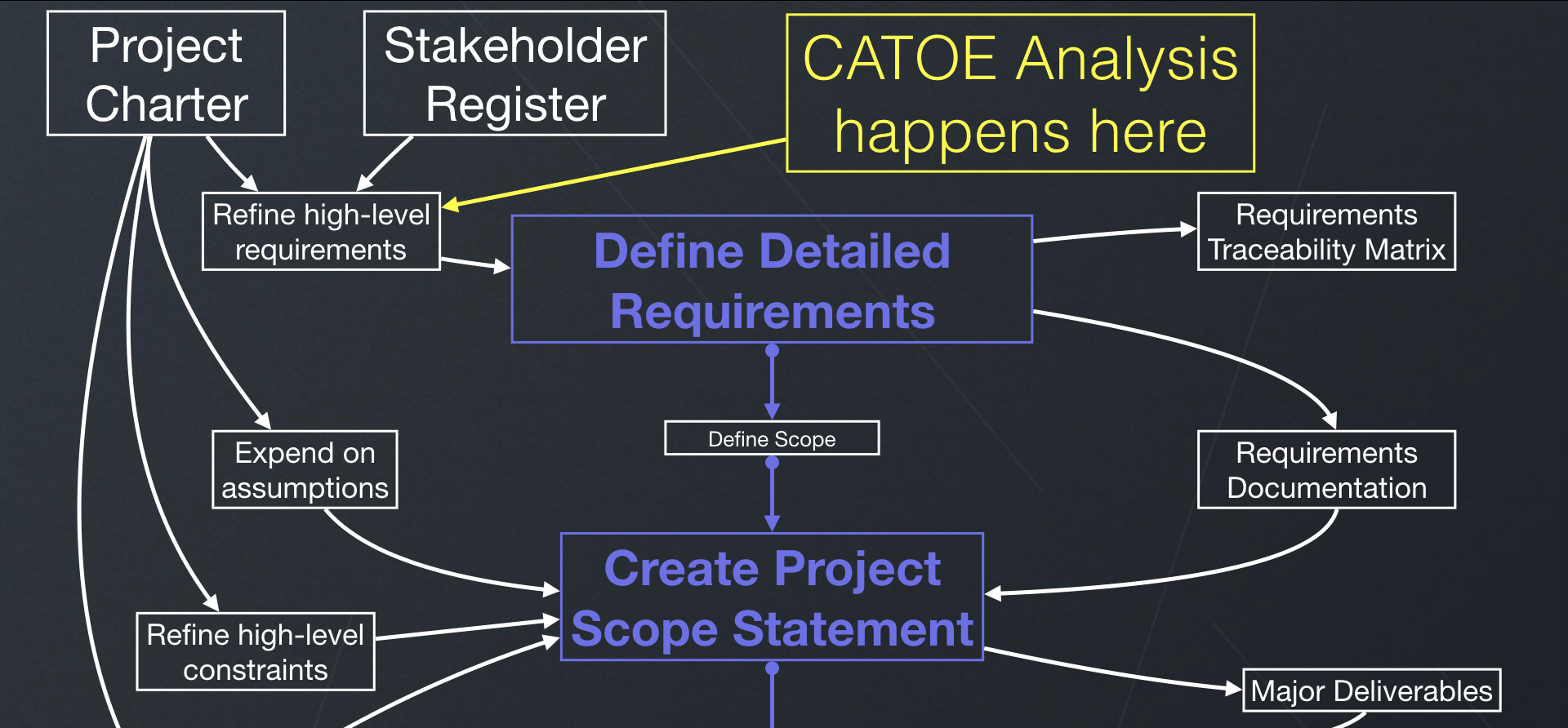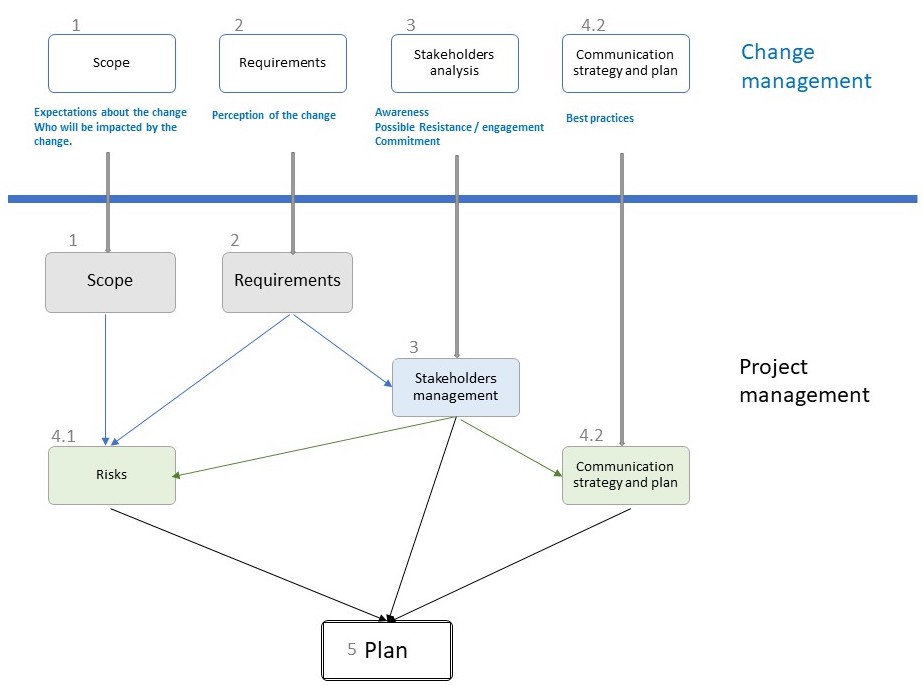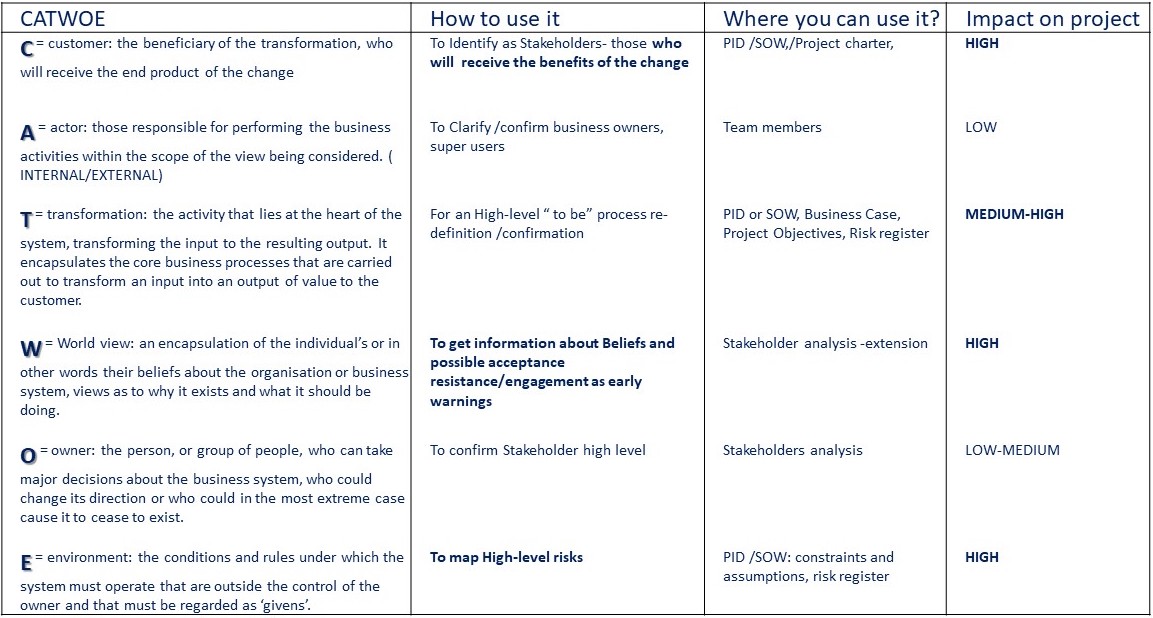In the previous post, I proposed an approach to help a PM to incorporate change management techniques to manage the change. It works even when there are no specific professional resources or particular skills related to Change Management.
Today we will talk about the elements you can bring into Project Management and the tools and techniques I used when managing change/transformation projects. I believe that you can successfully use them in your project tasks and project documentation.
The following diagram can help the preview of the information flow of how to embed CM into Project management activities.
1. How can CM be used to refine the project scope?
In CM, to define the project scope, we need to identify two main elements: expectations about the change and who will be impacted by the change. These elements are very detailed and usually are part of a specific process (see example).
A tool that helped me to incorporate CM scope elements into my transformational projects is CATWOE analysis.
- It is used “to prepare a rigorous and comprehensive root definition, as the basis for solving problems with multiple perceptions”.
- It aims to track down the perception of various stakeholders related to the change.
- It will help to define the root cause and agree on a final decision which will drive the changes.
Ideally, you should use this tool after high-level requirements gathering and before defining detailed-level requirements (see Dmitriy’s post here).

The results of CATWOE analysis will be included in the following project documentation:
- Project Charter/ PID/ SOW (amended version of the original documents)
- Stakeholders Analysis (adding the extended analysis – see point 3)
- Risks Register: the risks/opportunities we can gather form CATWOE analysis need to be regrouped in the “Change management” category (see point 4.1).
2. What can we add to the Requirements gathering phase?
In a Change management project, requirements are based on the readiness assessment and impact analysis on people and organization. The information collected is related to the middle management’s perception of the change in their role, in their department, for their subordinates. The final assessment is used in the plan.
The benefit is the assessment of the risks related to the project and information to customise “communication plans, training plans, coaching plans and sponsorship activities”.
From PM’s perspective, the readiness assessment can be aligned with the Analysis phase (Waterfall).
In my projects, I found it strategic to add four paragraphs to a possible existing Requirements documentation content. It led the Business Analyst or Functional Consultant to raise specific questions and embed the required information on people and organization and risks related to the change into the project.
You can consider the alternative use of surveys to ask for answers to these questions if there are Time and Budget constraints for the Consultants/Business Analyst.
3. What information can we use for Stakeholders management?
Change management discipline focuses on additional critical points such as management of stakeholders’ resistance vs engagement, awareness, commitment.
In implementation projects, A Stakeholders analysis is carried on to manage stakeholders and communicate with them. However, the CATWOE analysis can provide us with some valuable additional information that can help us to map and manage the points above and using them for risk management:
4. How and where can we embed this information in Project management tasks and governance?
4.1 See how Risk management register changes with the new information
As showed above, Requirements Gathering (2) and Stakeholders Mapping (3), conveniently adapted to include CM’s information, can give Project Managers the opportunity to identify and record different new possible risks and opportunities, resistance vs engagement.
This is a summary of the risks and opportunities which can be regrouped in the register on Change management:
4.2 See how we enhance the Communication management process
Based on the updated risks analysis, we can embed some of the CM’s elements into our communication strategy and plan.
- It’s a good practice to announce the change before starting a project and of course, highlighting why the change is You have defined these points in the scope and the extended stakeholder’s analysis),
- Best practices suggest that the sponsor of the change and their immediate managers/supervisors are the persons who need to communicate the strategic information to the teams. You, as project manager, are in charge to support these two figures in communicating the messages to the employees. You can agree on the communication plan (content and frequency) with them.
5. Change Management Techniques in Planning
The final recipient of all the activities related to adding change management techniques of the Project is the plan.
We now have the opportunity to:
- Add new CM-related tasks.
- Proceed with estimates and eventually a new resources allocation for activities required for the new tasks, if any.
- Consider and manage contingency time:
- Estimating and directly allocated time for critical risks, already discussed and agreed with the stakeholders, with mitigation actions as tasks, and show them in the planning and reporting activities.
- Indirectly estimating additional time for risks with low-medium impact with special reference to Training, Testing, Go-Live and Post go-live and allocating them in a buffering exercise.
- Evaluate further budget requirements for activities related to the points above.
Discuss these additional budget requirements with the steering committee or project board, if they are relevant, showing risks and stakeholders mapping as support to your request.
Conclusion:
The information in this post is not a substitution of any Change management methodology or discipline.
However, I hope you can consider them as a great workaround to add more techniques to your project. It helps to address critical elements of change management on any project.
Liked the article? Please share it on LinkedIn. Thanks in advance!

Luca Collina (BA, BSC & PM PRINCE 2 Certified) is an independent transformational consultant and PM (change management and ERP). If you are looking for a way to balance your tasks between project & change management send me a message directly to me at info@lucacollina.co.uk






